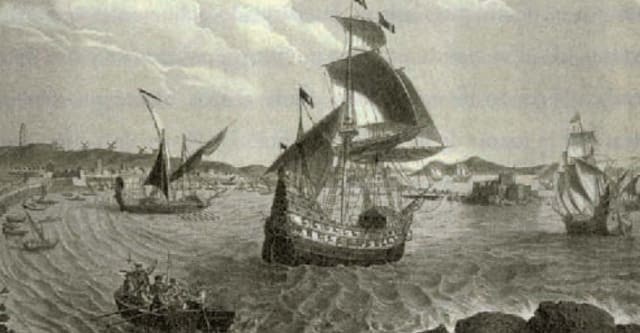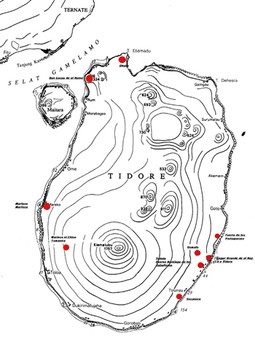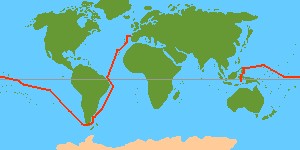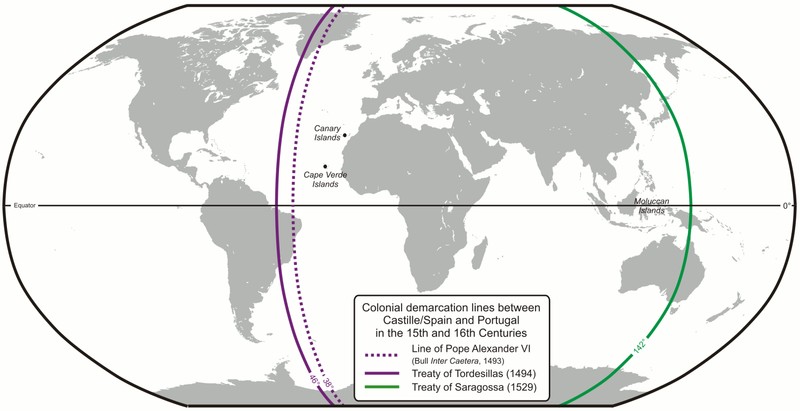The Loaísa Expedition
Introduction
Text-to-speech Audio
The second-ever circumnavigation to and from the Spice Islands was completed under the command of Spanish sailor Fray Garcia Jofre de Loaísa, who was sent sent in July 1525 to colonize the Spice Islands (modern-day Moluka and neighboring islands) and establish a foothold there until additonal settlers could make the journey. The Spice Islands were a huge trading center, and gaining control over it would give any European Country an advantage over its rivals. Loaísa started his journey from the La Caruña in northern Spain with 500 men. Only fifty survived the journey to Tidore Island, where they arrived in September 1526 - only to find that the Portuguese had gotten there first. After many skirmishes the Spanish surrendered to the Portuguese and were brought to Fort Kastela, leaving Spanish King Charles V no choice but to give up on the Spice Islands. It was not until the summer of 1536, eleven years afer their depature, that the two survivors returned to Spain to share their story.
Images
The Louisa Expedition

Spanish Forts Tidore



Backstory and Context
Text-to-speech Audio
The purpose of Loaísa’s expedition was to claim and colonize the Spice Islands for the Spanish. If successful, Jofre de Loaísa was promised governance over North Malucca Island. Before Portugal, Spain, England, or the Dutch made it to the Spice Islands, the Moluccans - a very diverse Austronesian speaking and Papuan speaking ethnic group - lived well by trading their locally grown spices. These spices, particularly nutmeg and cloves, were what made the Moluccan Islands so special and gave them their nickname. The Spice Islands promised huge profits to the European nation that could control their trade. Loaísa's expedition of 450 total sailors on seven huge ships was extremely important to King Charles V, because Spain was behind in the race to the Spice Islands (the Portuguese had landed in 1522). The expedition departed from Spain on July 24, 1525.
Loaísa’s first half of the trip was uneventful. Sailing south, he initially paralleled the African coast, then west across the Atlantic Ocean to Brazil. In January a huge storm hit the fleet, scattering all but three ships from one another. Another three were shipwrecked or got lost and abandoned the expedition. One, the San Lesmes, was blown far off course to the south and discovered what is now known as Mar de Hoces (a sea connecting the Atlantic and the Pacific south of the Magellan Strait) before reunited with the Loaisa’s fleet.
On May 26, 1526, the four remaining ships passed through the Strait of Magellan and entered the Pacific Ocean. Again bad weather hit the group, scattering the ships. Three of the four disappeared. Santa Maria, the flagship, was the only ship left. Then sickness hit the ship. Loaísa died on July 30, 1526. Soon Sebastion Elcano, who had taken up his position, died as well. Alonso de Salazar, third in command, brought the ship to the Ladrones Islands in the Philippines before also dying of sickness. After repairing the Santa Maria Martin Iniguez de Carquizano, the fourth man to captain the ship during its transit across the Pacific, journeyed south through the Philippines and landed in Tidore on New Year's Day, 1527.
Upon landing in Tidore, Carquizano befriended the Tidorese King who ruled over the Duko (Sultanate of Tidore), and also reached out to Chief of Jilolo on the west coast of North Molucca asking for an alliance. The chief agreed because he had been having trouble with the Portuguese since their arrival in 1522. The leader of the Portuguese, Garcia Henriques, heard of the Spanish landing and demanded that they come to visit Fort Kastela in Ternate. This led to a skirmish resulting in a temporary victory for the Spaniards. Shortly afterwards, however, the now-decripit Santa Maria was destroyed in a short, thus stranding the Spaniards on Tidore. They held out for two years, but were at last forced to surrender on October 28, 1529. After hearing of this defeat, Charles V withdrew from the competition for the Spice Islands and left it for the Portuguese. Hernando de la Torre and Andres de Urdaneta, the only survivors from the nearly five hundred men who had departed Spain in 1525, finally returned home in 1536
Fray Garcia Jofre de Loaísa was an important figure whose journey marked an inflection point in the power struggle between European countries. The Treaty of Zaragoza (or Saragossa), resulting from the Spice Islands struggle, gave Portugal the entire Moluccas by creating a line dividing the world into two “halves.” Although Spain was under the impression that these halves were equal, the Portuguese, who drew and decided upon the line, gave themselves a little more than half - just enough to gain control over the entire Molucca region. Fun Fact: Sir Isaac Newton used the measurements that the Portuguese had fudged in order to foil the Spanish. Thus his figure for the radius of the world was off by 14%, and as a result he wasn’t able to properly finish his inverse square gravity law when calculating the gravitational force of the moon!
Sources
Nowell, Charles E. "The Loaisa Expedition and the Ownership of the Moluccas." Pacific Historical Review 5 (1936): 325–336.
Ramerini, Marco. "Tidore: The Spanish forts on the island of Tidore, 1606-1663." Colonial Voyage. Accessed December 11th, 2022. https://www.colonialvoyage.com/tidore-spanish-forts-island-tidore-1606-1663/.
de la Torre, Hernando. 1525-1528. Journal of the expedition to the Philippine Islands, under the command of Fray Garcia Jofre de Loaísa. British Library, Add. MS 17626. Available through Adam Matthew, Age of Exploration. http://www.exploration.amdigital.co.uk/Documents/Details/BL_Add_MS_17626 [Accessed December 11, 2022].
The National Museum of Australia. Wikipedia Source
Marco Ramerini Colonial Voyage Tidore
